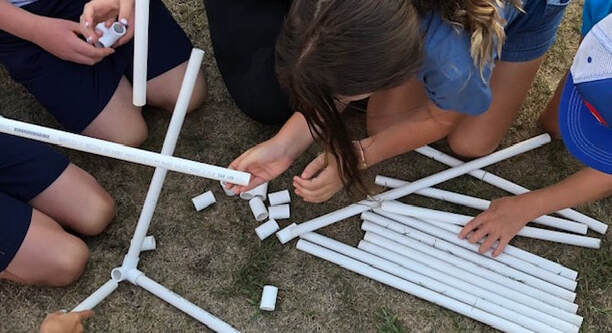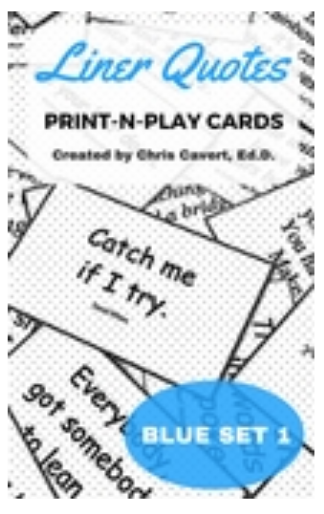When I first started using PWCP, I felt the need to show my groups how Word Circle Puzzles (WCP) worked (the first iteration of Circle Puzzles). We would play out one or two WCP as a big group, then I would divide the larger group into smaller groups of three or four participants to solve this picture puzzle. Recently, I've chosen to skip the WCP introduction, adding a little more challenge to the cognitive aspect of the task - struggling a bit with the big 'picture' so to speak.
Set Up and Play
Each group working around a table (or a group of desks) is ideal, but they can all work the cards around on the floor or ground if you don't have the table/desks option.
First you'll need to print out the PWCP (find the PDF download below). Each small group of three or four participants will need a puzzle (this puzzle includes 16 picture cards). NOTE: I laminate my puzzle cards for long term use. The card set also includes eight Help Cards.
Choosing the number of Help Cards to put in play will determine the level of challenge. If you put 12 Help Cards in play the puzzle will be pretty easy to solve - if the group collaborates by sharing information and not 'waisting' the Help. Putting 10 Help Cards in play is a little more challenging, groups have to make more educated guesses (ideally together,) and they can still collaborate without using Help Cards. Putting eight Help Cards in play makes it a pretty difficult challenge, but the puzzle can be solved if all the small groups work together by sharing information and strategically using Help Cards.
An Example of Play: Let's say you have 24 participants. You divide them into six groups of four and direct each group to move into an area away from other groups (separating the groups with some distance - when possible - is purposefully done so it's a bit more challenging to see and share information - look up 'activation energy' for some psychological connection.) You give each group the Picture Word Circle Puzzle saying:
"I'm now going to give each group a puzzle to solve. Each puzzle has a set of pictures. Your objective is to first name each picture using one word. Then, figure out how to connect each word, picture card, with another word, picture card, so that all the picture card words form one circle of connections. For example....." (If needed, you'll want to do a little research on Word Circle Puzzles in order to explain how to describe the process - intro info to Word Circle Puzzles is HERE. BTW: There are TONS of FREE Word Circle Puzzles at the FUNdoing Blog - use the Search feature - put in Word Circle Puzzles - to find them.)
You've decided to use 10 Help Cards - five of each kind (see the header picture above for the two kinds). You distribute two Help Cards to four groups and one Help card to the remaining two groups (the distribution of resources is not always 'fair'). Explain that the groups can use the Help Cards to ask you the question on each card at any time during the challenge.
Be sure to provide time for the groups to ask you confirming and clarifying questions before getting started. Be careful not to solve any problems for them at the onset. You can use my favorite response when appropriate, "I'll leave that up to the group to decide." If they ask the 'Golden Question' right off the bat, they're ahead of the game: "Can the small groups work together on this?" I respond, "That is not against any of the rules."
Be sure to set a time limit for the task to add a little pressure. I believe it can be solved in five minutes or less if all groups work together and share resources. However, I've yet to see this occur. Giving them 20 minutes is a good length of time to pull out a lot of learnings.
A Nudge
Solving this Picture Word Circle Puzzle is very difficult without 'Help' or sharing ideas with other groups. I'm still fascinated by the resistance of the participants to use their resources in order to move ahead. The resistance to working together with others is fairly common in team building activities when there is a perceived notion of competition - we see it all the time.
This leads me to a tool I use as an educator whenever the groups are still struggling after 15 minutes of working on the task and have yet to share ideas with any of the other groups. I take a countdown 'time-break' to get their attention. I ask a few questions about how it's going, what's working, what isn't. Then, I start up the time again and share, "You are all working on the same puzzle." Sometimes this turns on lightbulbs, other times it doesn't.
Processing
As always, be observant of behaviors and make note of the questions related to the groups' behaviors. Here are some that always seem to surface for me:
- What were the resources available to you during the task?
- How well did you utilize the resources you knew about?
- How long did it take you to utilize your resources?
- What prevented you from using your resources?
- Once you heard you were working on the same puzzle, what, if anything, changed?
- What advice do you hear about on a regular basis? Who gives you this advice? What influences your decision to follow, or not follow, someone's advice?
- What resources in your life are useful to you right now? Which ones are you not using? What resources might you be overlooking?
Extension
Here's something I'd like to try in the near future. After the groups have gone through an enlightening processing session over this first Picture Word Circle Puzzle (??!!), I want to give them another attempt. I'll set up the same task, in the same way, with a different Picture Puzzle. Will they use their recently acquired information/knowledge to successfully complete the task in less time? (Want to try it? You can find the Picture Word Circle Puzzles Kit, with six more Picture Puzzles at the FUNdoing Store. Let us know how it goes.)
Here's The First-Ever Picture Word Circle Puzzle:
| picturewordcirclepuzzle_set1.pdf |
Chris Cavert, Ed.D.








 RSS Feed
RSS Feed